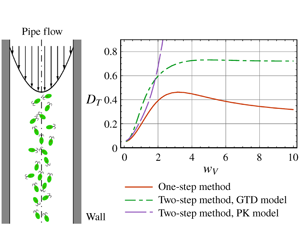Article contents
Dispersion of gyrotactic micro-organisms in pipe flows
Published online by Cambridge University Press: 24 February 2020
Abstract

The transport of motile micro-organisms exhibits rich and complex phenomena, of significance to various biological and environmental applications. For dilute suspensions of gyrotactic algae dispersing in vertical pipe flows, previous studies obtained only approximate values for the overall drift and dispersivity in the longitudinal direction, using two-step averaging methods with the Pedley–Kessler (PK) model and the generalized Taylor dispersion (GTD) model. These two-step methods impose restrictive assumptions: both the swimming Péclet number and the variation of shear rates relative to swimming must be sufficiently small. Thus, it is difficult to analyse the gyrotactic dispersion process in the ‘breakdown’ parameter region. Following a recent study of Jiang & Chen (J. Fluid Mech., vol. 877, 2019, pp. 1–34), this paper applies the integrated and precise one-step GTD method to study the overall dispersion process and performs a quantitative test for the applicability of two-step methods. An appropriate function basis for series expansions in the GTD method is proposed to deal with reflective boundary conditions imposed at the tube wall. Detailed results for Chlamydomonas nivalis are presented to illustrate the influence of the gyrotactic focusing on the overall dispersion process, for both downwelling and upwelling flows. The overall drift above the mean flow increases monotonically with the flow rate. However, the overall dispersivity will first decrease, then increase, and finally saturate as the flow rate increases, due to a combined effect of gyrotaxis, swimming and convection. Shear alignments of prolate cells will weaken the focusing, and thus reduce the drift and enhance the dispersivity. The predictions by two-step methods with the PK and GTD models are found to be successful inside their required parameter region. Within the ‘breakdown’ region, the two-step GTD method still gives reasonable results for the local distribution and the drift, but fails in the predictions of dispersivity.
- Type
- JFM Papers
- Information
- Copyright
- © The Author(s), 2020. Published by Cambridge University Press
References
- 24
- Cited by


